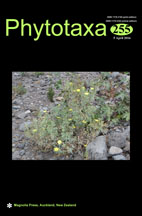Abstract
Completion of a detailed monograph of Hypericum using traditional methods has stimulated the publication of phylogenetic treatments of the genus using molecular methods. The relationships thereby revealed differ from those of the traditional account in several ways that are discussed here.
A key point of conflict concerns taxa that share a specific set of morphological characters, i.e. the ‘Elodes’ syndrome (pseudotubular corolla, sterile stamen fascicles, stamen filaments ± united in the fascicle and sometimes petal appendages), which was found to be paraphyletic in each molecular study. The various groups with this syndrome were shown to have arisen from various parts of Hypericum, apparently suddenly, probably as the result of a genetic switch, the action of which can also be reversed. The formerly segregated genera with this floral syndrome should therefore all be re-incorporated in Hypericum. This necessitates the re-establishment of one section, namely Hypericum sect. Elodea, and recognition of two new sections within Hypericum, namely Hypericum sect. Lianthus and Hypericum sect. Thornea, which are proposed here.
The remaining species have resolved in various places in recent molecular phylogenetic trees that differ from each other and from the classification adopted in the monograph. In particular, in molecular results the herbaceous species with ‘3’ (i.e. 2+2+1) stamen fascicles all form a single clade; whereas, in the traditional treatment adopted in the monograph, they form three distinct, distantly related groups.
In light of recent molecular studies, Hypericum is now interpreted to comprise two distinct groups (respectively mainly Old World and mainly New World) that differ in the presence or absence of dark (hypericin-containing) glands and in the arrangement of the stamen fascicles. These two clades are described as subgenera, with the New World clade named Hypericum subgenus Brathys. By drawing attention to this grouping, the molecular work has improved on the monograph.

